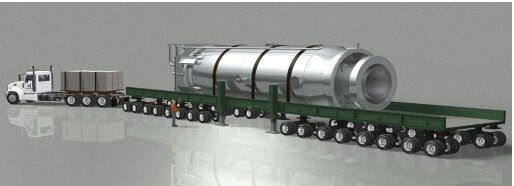Want more nuclear power? Don't read this – you'll just get bummed out.

Photo above - computer rendering of a NuScale modular nuke reactor on it's delivery truck. Is that a 98 wheeler? Do those things even exist? Never mind - that reactor project just got cancelled.
I have to confess - I DON'T have any hatred of nuclear power plants. There's one about 100 miles from my place in Florida. Not close enough to see every day, but close enough to make the area “Chernobyl like” in a worst-case scenario. But I'm NOT worried. What DOES worry me is that America evidently cannot find a winning formula for building nuclear power plants in the year 2023. See link below.
This article in Bloomberg was an eye opener. Right at the start they drop a bombshell - the average cost overrun to build a nuke plant is 120%. Imagine going to a car dealership and finding out the final sales price of your Toyota Camry is $90,000, not the $40,000 you agreed to. And that there's nothing you can do about it. You HAVE to pay up, per a 1,800-page contract involving state regulators, federal regulators, etc. which allows unlimited last-minute fees and charges.
Here's why that average cost overrun is so astonishing. A typical nuclear power plant isn't at all like a Toyota Camry. It's more like a Rolls Royce – which has to be assembled right in your driveway, over a 24-month period. And most of the workers have at best done this once or twice in their lives. The typical nuclear power plant was a bespoke, hand-built item. That's how America USED to build nuclear power plants. And that's what made people nervous. No two were exactly alike. Every time they built another one, dozens of details would likely change, including the type of control rods, the cooling system, and even the location of the emergency “off” switch.
Enter a company called NuScale. “We got this”, they assured everyone. NuScale came up with the Toyota Camry of nuclear power plants. Smaller in scale. Modular – most portions bolted together on a factory assembly line, then transported to the site. Repeatable processes. The same user's manual, over and over. Spare parts will already be in the warehouse, when you need them. What's not to like?
Evidently, the price. Not the purchase price of the Camry/nuke plant - the cost of the electricity it generates. NuScale just admitted they can't push electrons into wires for the original promised price. They need to nearly double the rate they will charge for electricity. If this sounds to you like the flip side of a record called “120% construction cost overrun”, congrats for paying attention.
To be fair to NuScale, today's price hike is only 53%. But the plant isn't even built yet. Can more price hikes be ruled out? Probably not. Do users of the plant's proposed electricity want to bail now? Yes they do. NuScale plant be cancelled. Too bad – it would have generated more electricity than a forest of wind turbines, even though it was considered small scale.
The current (increased) price of NuScale electricity – if the plant got built, and there were no more surprises – would be $89 per MWh. I realize you have no idea what YOU actually pay. Let's make this easy: when electricity producers buy and sell wholesale juice on the grid, it typically goes for $22-$50 per MWh. NOW do you see why the NuScale plant fell out of favor?
NuScale electricity prices are not only seriously out of line with the market, but it would also instantly be THE MOST EXPENSIVE (per MWh) source of nuclear electricity on Planet America. Nuclear electricity in general is already at $80 per MWh. Nobody is clamoring for $90, a rate which could likely still go higher. There's a Wikipedia link at the bottom if you want to do a deep dive about how much it costs to generate electricity from all known sources. The short story – natural gas, solar, and wind have some of the lowest costs, depending on the site and operator. And “biomass”, which nobody uses, is the most expensive.
Now here's where I have some fun, as usual. How much did the NuScale power plant cost before they pulled the plug? In 2014, the Obama administration kicked it off with $600 million. In 2020 the Trump administration doubled down, with another $1.4 Billion. So, we're already at $2 billion in taxpayer subsidies, and there will be no reactor, and no electricity. Geez Louise – we coulda' bought a B2 bomber for that, speaking of 100% cost overruns. (Full disclosure – I am not in favor buying any more of the B2 bombers than we already have. Ten seems to be enough, since they never get used).
I've never said Solar and Wind Turbine energy are evil. And I'm not saying that nuclear power is, in today's post. But clearly federal agencies throwing billions and billions of taxpayer money at corporations without even knowing the cost per MWh is ludicrous. Whether it's the Rolls Royce of electric plants, or the Camry.
I'm just sayin' . . .
NuScale Cancels Small Nuclear Reactor Power Plant in Utah as Costs Climb - Bloomberg
Cost of electricity by source - Wikipedia


